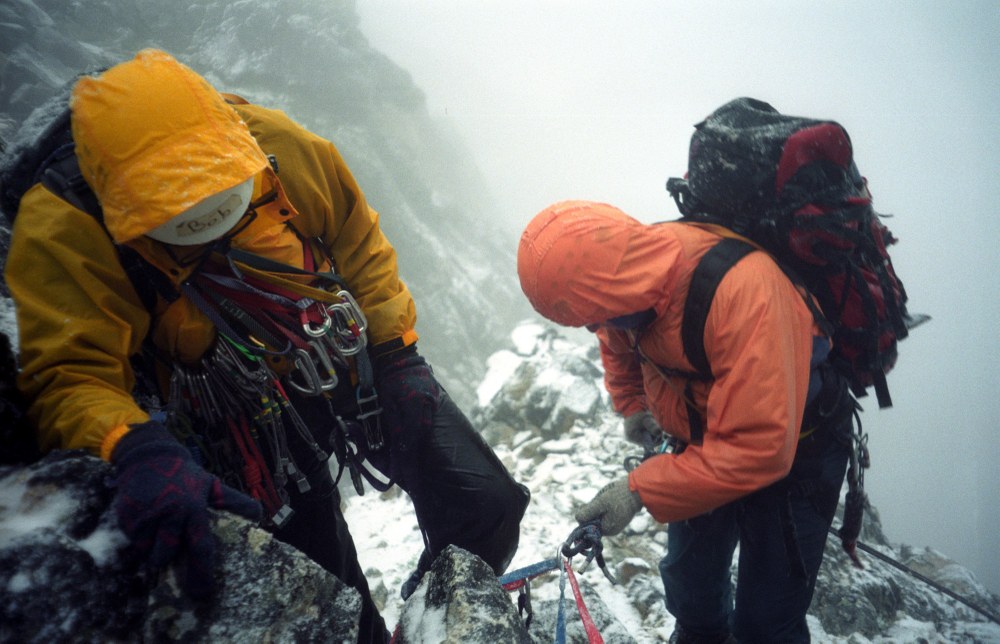
The group ended up coming out early-morning on day-five of what was supposed to have been a three day climb. That things turned out as well as they did can be attributed to good group problem solving and preparation by the climb leader.
[Assistant Leader]
The weather looked auspicious when we set off along the PCT towards Goode, with small clouds scudding across the sky in mostly sunny conditions. This was a long, intermediate grade rock climb of the NE buttress of Goode, one of the giants of the North Cascades. The six of us made good time into Bridge Creek from where we forded the creek and scrambled up the side of a waterfall to the benches below the Goode glacier to make camp for the night under our leader's 'MegaMid', a large, lightweight pyramid shaped tent for a group.
The morning was fine, with a high layer of cloud, and we cramponed up the glacier to make it via a gulley to the lower buttress. Being a team of six, we moved a little more slowly than we might have, and we were only half way up the route by lunch time. The rock pitches dragged on: some belayed, some simul-climbed and by late afternoon, we found ourselves a pitch below the summit being snowed on!
A weather system had moved in unseen from the opposite side of the mountain, and in mid-July we found ourselves mid-winter. The first rope team quickly established an anchored line from the summit, which the remaining climbers could then climb with self-belay from a prussik. Around 6pm our complete party found ourselves on the spacious summit of Goode, wondering how we were going to get back to camp, since the original plan had been to cross to the Storm King col on the north side of Goode, from where you can scramble back to the benches.
The climb leader fortunately had packed a few pitons - one of which served as a rappel anchor, since down-climbing the slick, snowbound rock was now out of the question, and there were no other anchor points. By sundown we found ourselves a pitch below the summit next to a small alcove big enough for half the party, and another pitch below that, a small ledge for the remainder. In the continuing snowfall, we settled in for a bivy in the icy melt-water on the ropes and whatever comfort we could find in our waterlogged backpacks.
During the night, there was a commotion in the upper bivvy. While trying to doze, one of the climbers had been struck in the head by a pebble ricocheting from somewhere, and a good deal of time was spent bandaging him up in the darkness. Fortunately, his wound turned out to be superficial, though it bled a good deal.
Morning broke on frozen ropes and a technical descent down rock still covered in snow, so our collective judgement was to abandon the original Storm-King idea, and beat a retreat to Stehekin to recover our strength. After a number of rappels, we arrived at the Stehekin road, and picked up the NPS bus to the Stehekin lodge, which fortunately had a space for weary and stressed climbers. After some dinner, we used the single public phone in Stehekin to let family members know we would be much delayed, since we were now on the wrong side of the mountain, far from our camp and the cars at Rainy Pass.
Assessing the group's resources, we found that besides the injured climber, the leader was suffering foot pain, since his approach/rock shoes were not suited to miles on the trail, and we had around 25 miles to climb back up to the high camp (to retrieve wallets and car keys amongst other items), and then return to the cars. Additionally, one party member was obliged to leave early for Seattle via sea-plane. That left three alpinists to make the long trek back to high camp, retrieve six climbers' gear, and retreat to Rainy Pass.
Offloading some hardware to the remaining two climbers who hiked directly to the cars via the PCT, the other three successfully cleared the camp and rendezvoused at Rainy Pass after a taxing 18-hours through the night into the fifth day.
In retrospect, this climb might well have been a disastrous trip; we all felt relieved to have stories to recount rather than more serious consequences. Preparation and prior experiences made all the difference in this outcome.
Add a comment
Log in to add comments.Quite a trip! What was the weather forecast?
 Peter Clitherow
Peter Clitherow